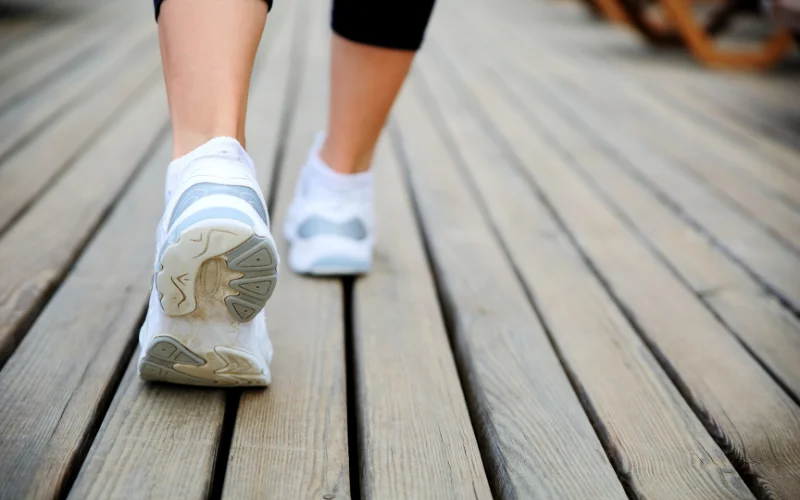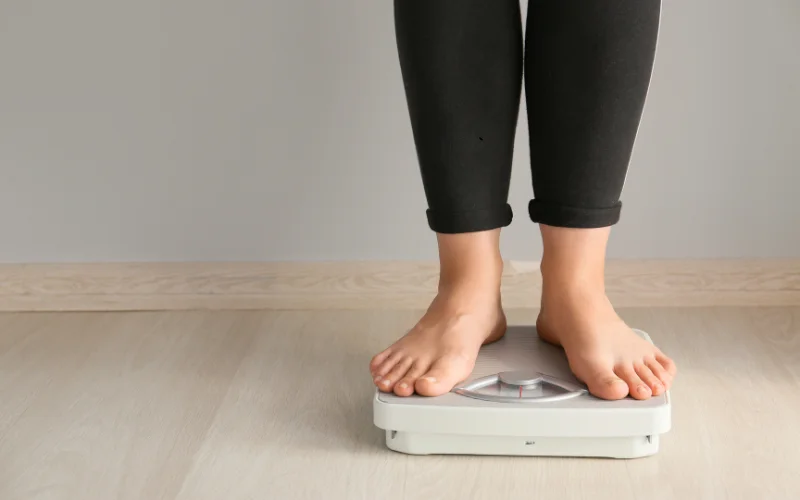Trying to lose 20 pounds? Yeah, me too. It’s crazy how many of us are in the same boat, right? I’ve been googling “how long does it take to lose 20 pounds” more times than I’d like to admit. Here’s the thing – there’s no magic number. Your body, my body, we’re all different. But don’t let that get you down! I’ve done some digging and talked to a few experts, and I am here to share the good stuff. We’ll look at what works, bust some myths, and even dive into some weird but intriguing ideas like using saunas for weight loss.
How Long Does It Take to Lose 20 Pounds With Exercise?

Let’s talk about dropping those 20 pounds through exercise – how long are we looking at here? Well, it’s not a one-size-fits-all answer, but here’s the scoop: It all boils down to calories. You’ve probably heard that you need to burn 3,500 calories to lose a pound. So, do the math – we’re aiming for a 500-750 calorie deficit daily to lose 1-2 pounds a week. At that rate, you’re looking at 10 to 20 weeks to hit your 20-pound goal. Now, exercise is your best friend here. Hop on a bike or go for a jog for 30 minutes, and you could torch about 300 calories.
But here’s the thing – your results will vary based on your starting point, how hard you’re pushing yourself, and how often you’re breaking a sweat. Mix in some HIIT to fire up that fat burn, and don’t forget about lifting weights – it’ll rev up your metabolism. Just remember, while hitting the gym is great, what you put on your plate matters too. It’s all about finding that sweet spot between moving more and eating smarter. Stick with it, and you’ll be rocking those skinny jeans before you know it!
How Long Does It Take To Lose 20 Pounds?

When it comes to losing weight in a healthy, sustainable way, the journey can look different for everyone. Let’s break it down for both men and women to give you a clearer picture.
Men
Men typically have a higher muscle mass and faster metabolism compared to women, which can affect their weight loss journey. On average, a healthy rate of weight loss for men is about 1-2 pounds per week. This means losing 20 pounds could take anywhere from 10 to 20 weeks.
Factors that influence the timeline for men include:
- Starting weight and body composition.
- Age (metabolism tends to slow down as men get older).
- Activity level and exercise routine.
- Diet and calorie intake.
- Hormones, particularly testosterone levels.
Men might see faster initial results, especially if they incorporate strength training into their routine, as building muscle can boost metabolism. However, it’s important to focus on sustainable habits rather than quick fixes.
Women
Women’s bodies tend to hold onto fat more stubbornly due to evolutionary and hormonal factors. A healthy rate of weight loss for women is also around 1-2 pounds per week, meaning 20 pounds could take between 10 to 20 weeks to lose.
Factors that affect the timeline for women include:
- Starting weight and body composition.
- Age and life stage (e.g., pre-menopause, menopause).
- Hormonal fluctuations throughout the menstrual cycle.
- Pregnancy and postpartum recovery.
- Activity level and exercise routine.
- Diet and calorie intake.
Women might experience more fluctuations in their weight loss journey due to hormonal changes. Women must focus on overall health, including proper nutrition and a mix of cardio and strength training, rather than just the number on the scale.
For both men and women, it’s important to remember that healthy, lasting weight loss is a gradual process. While the 10-20 week timeline is a general guideline, individual experiences may vary. The key is to create sustainable lifestyle changes that promote overall health and well-being, rather than pursuing rapid weight loss that may be hard to maintain in the long run.
Teaming Up Diet and Fitness for the Win

When aiming to lose 20 pounds, the synergy between nutrition and exercise is crucial. While many wonder how long it takes to lose 20 pounds, the answer largely depends on how well you coordinate your diet with your workout routine. Let’s explore how to optimize this balance for maximum fat loss.
1. Calorie Timing
- Pre-Workout: Consume a balanced meal 2-3 hours before exercising, focusing on complex carbohydrates and lean proteins to fuel your workout.
- Post-Workout: Within 30 minutes after exercise, have a protein-rich snack with some carbohydrates to aid muscle recovery and replenish energy stores.
2. Macronutrient Balance
- Protein: Increase protein intake to 1.6-2.2 grams per kg of body weight to support muscle maintenance and recovery during weight loss.
- Carbohydrates: Time carb intake around workouts for energy, reducing overall intake on rest days.
- Fats: Include healthy fats to support hormone function and satiety, but moderate intake to manage overall calories.
3. Hydration Strategy
- Drink water before, during, and after workouts to support performance and recovery.
- Aim for at least 8-10 glasses of water daily, increasing intake on exercise days.
4. Meal Frequency
- Consider eating smaller, more frequent meals to maintain stable energy levels throughout the day, especially if you’re exercising regularly.
5. Nutrient Timing for Different Workouts
- Strength Training: Focus on protein and carbs post-workout to support muscle repair and growth.
- Cardio: Emphasize hydration and electrolyte balance, especially for longer sessions.
6. Supplementation
- Consider supplements like whey protein or BCAAs to support muscle recovery and growth, particularly if struggling to meet protein needs through diet alone.
7. Avoiding Common Pitfalls
- Don’t drastically cut calories, as this can slow metabolism and hinder workout performance.
- Avoid the temptation to “eat back” all calories burned during exercise.
While many searches for how to lose belly fat overnight (easy trick), it’s important to understand that sustainable fat loss comes from consistent, long-term habits. By syncing your nutrition with your exercise routine, you create an environment where your body is primed to burn fat efficiently.
Remember, losing 20 pounds healthily typically takes 10-20 weeks, depending on various factors. Focus on creating a small calorie deficit through diet and increasing energy expenditure through exercise. This balanced approach ensures you’re losing fat while maintaining muscle mass, leading to better long-term results and a higher likelihood of maintaining your weight loss.
By fine-tuning your nutrition to complement your workout routine, you’ll optimize your body’s fat-burning potential and make steady progress towards your 20-pound weight loss goal.
Your 20-Pound Walking Adventure

Losing 20 pounds through walking is an achievable goal with consistent effort and dedication. The duration varies based on individual factors, but walking can be an effective weight loss strategy. To maximize your results:
- Aim for 30-60 minutes of walking daily.
- Start with a comfortable pace of 2.5-3 mph for beginners.
- Progress to a brisk pace of 3-4 mph for moderate intensity.
- Aim for 4-5 mph for vigorous walking, if fitness allows.
- Incorporate interval training: alternate between fast and slow speeds.
- Gradually increase speed and distance over time.
- Use inclines or stairs to boost calorie burn at any speed.
- Maintain proper form: engage core, swing arms, and take quick steps.
- Track steps and speed with a pedometer or fitness app.
- Combine walking with strength training for optimal results.
Remember, sustainable weight loss occurs gradually. While walking speed affects calorie burn, consistency is key. Pair your walking routine with a balanced diet for the best results. Focus on steady progress and listen to your body as you work towards your 20-pound weight loss goal.
20 Effective Strategies For How Long Does It Take to Lose 20 Pounds?

Achieving rapid weight loss requires a multifaceted approach combining diet, exercise, and lifestyle changes. The following strategies are designed to accelerate your weight loss journey but remember to consult with a healthcare professional before making significant changes to your routine.
1. Intermittent Fasting
Restrict your eating to a specific time window each day, typically 8-10 hours. This approach can help your body enter a fat-burning state and reduce overall calorie intake.
2. High-Intensity Interval Training (HIIT)
Incorporate short bursts of intense exercise followed by brief recovery periods. HIIT workouts boost metabolism and continue burning calories long after you’ve finished exercising.
3. Ketogenic Diet
Dramatically reduce carbohydrate intake while increasing healthy fats. This diet aims to put your body in ketosis, a state where it efficiently burns fat for fuel instead of carbs.
4. Increased Protein Intake
Consume more lean protein sources like chicken, fish, and legumes. Higher protein intake can boost metabolism, preserve muscle mass during weight loss, and keep you feeling fuller for longer.
5. Hydration Optimization
Make a conscious effort to drink more water throughout the day. Proper hydration supports metabolism, can reduce hunger, and helps replace high-calorie beverages in your diet.
6. Sleep Quality Improvement
Prioritize getting 7-9 hours of quality sleep each night. Good sleep helps regulate hunger hormones, reduces stress, and supports overall weight loss efforts.
7. Stress Management
Implement stress-reduction techniques such as meditation, deep breathing, or yoga. Managing stress can help lower cortisol levels, which when elevated, can contribute to weight gain.
8. Green Tea Consumption
Incorporate several cups of green tea into your daily routine. Green tea contains compounds that may boost metabolism and aid in fat burning.
9. Fiber-Rich Diet
Focus on eating more high-fiber foods like vegetables, fruits, and whole grains. Fiber promotes feelings of fullness, improves digestion, and can help reduce overall calorie consumption.
10. Strength Training
Include regular resistance exercises in your fitness routine. Building lean muscle mass increases your resting metabolic rate, helping you burn more calories even when you’re not exercising.
11. Meal Prepping
Dedicate time to planning and preparing your meals in advance. This strategy helps control portion sizes, ensures balanced nutrition, and reduces the likelihood of impulsive, unhealthy food choices.
12. Cutting Out Processed Foods
Eliminate or significantly reduce processed foods from your diet. Instead, opt for whole, nutrient-dense foods that naturally help you consume fewer calories while providing better nutrition.
13. Mindful Eating
Practice eating slowly and without distractions like TV or phones. This approach helps you better recognize hunger and fullness cues, potentially leading to reduced calorie intake.
14. Cardiovascular Exercise
Engage in regular cardio workouts such as running, cycling, or swimming. Consistent cardiovascular exercise burns calories and improves overall health, supporting weight loss efforts.
15. Apple Cider Vinegar
Consider adding small amounts of apple cider vinegar to your diet. Some studies suggest it may help stabilize blood sugar levels and support weight loss, though more research is needed.
16. Tracking Food Intake
Use a food diary or app to log everything you eat and drink. This practice increases awareness of your eating habits and helps you stay accountable to your weight loss goals.
17. Reducing Alcohol Consumption
Cut back on alcoholic beverages or eliminate them. Alcohol is high in empty calories and can hinder your body’s fat-burning processes.
18. Increasing Non-Exercise Activity Thermogenesis (NEAT)
Look for ways to move more throughout your day, such as taking stairs, walking instead of driving short distances, or using a standing desk. These small activities add up to increased calorie burn.
19. Probiotics and Gut Health
Incorporate probiotic-rich foods or supplements into your diet. A healthy gut microbiome may contribute to better weight management and overall health.
20. Cold Exposure
Experiment with brief periods of cold exposure, such as cold showers or cryotherapy. Some research suggests this may activate brown fat, a type of body fat that burns calories to generate heat.
Green Lights and Red Flags on Your Weight Loss Track

Losing weight isn’t just about diet and exercise – it’s a complex interplay of various factors in your life. Let’s explore the key elements that can either turbocharge your weight loss or put the brakes on your progress:
1. Metabolic Rate
Your metabolic rate is the foundation of weight loss, determining how many calories your body burns at rest. A higher metabolic rate can accelerate weight loss by burning more calories throughout the day, even when you’re not actively exercising. Factors like muscle mass, age, genetics, and certain health conditions can influence your metabolic rate. Building lean muscle through strength training, staying active, and eating metabolism-boosting foods can help increase your metabolic rate, while a sedentary lifestyle and extreme calorie restriction can slow it down.
2. Sleep Quality
The importance of sleep in weight loss cannot be overstated. Quality sleep regulates hunger hormones, balances cortisol levels, and supports muscle recovery. Lack of sleep can lead to increased cravings, particularly for high-calorie foods, and can impair your body’s ability to process carbohydrates effectively. Aim for 7-9 hours of uninterrupted sleep each night to support your weight loss efforts. Establishing a consistent sleep schedule, creating a relaxing bedtime routine, and optimizing your sleep environment can all contribute to better sleep quality and, consequently, more effective weight loss.
3. Stress Levels
Chronic stress can be a significant obstacle to weight loss. High stress levels lead to elevated cortisol, which can increase appetite, particularly for comfort foods high in sugar and fat. Stress can also disrupt sleep patterns and lead to emotional eating. Managing stress through techniques like meditation, yoga, deep breathing exercises, or regular physical activity can help mitigate these effects. By keeping stress levels in check, you remove a major roadblock to weight loss and create a more conducive environment for your body to shed excess pounds.
4. Hydration
Proper hydration plays a crucial role in weight loss, yet it’s frequently overlooked. Water is essential for metabolic processes, including the breakdown of fat. Staying well-hydrated can also help reduce hunger, as thirst is often mistaken for hunger. Drinking water before meals can lead to reduced calorie intake, and replacing high-calorie beverages with water can significantly cut overall calorie consumption. Aim for at least 8 glasses of water per day, and consider drinking a glass before each meal to support your weight loss efforts.
5. Dietary Composition
The balance of macronutrients (proteins, carbohydrates, and fats) in your diet can significantly influence the speed and effectiveness of weight loss. A diet high in protein can boost metabolism, reduce appetite, and help preserve muscle mass during weight loss. Complex carbohydrates provide sustained energy and fiber, aiding in satiety, while healthy fats are essential for hormone production and nutrient absorption. Finding the right balance for your body and lifestyle is crucial. Extreme restrictions in any macronutrient group can lead to nutritional deficiencies and may slow down your weight loss progress in the long run.
6. Exercise Intensity and Frequency
The type, intensity, and frequency of your physical activity play a pivotal role in determining your weight loss speed. High-Intensity Interval Training (HIIT) can boost metabolism and continue burning calories long after the workout. Strength training builds muscle mass, which increases your resting metabolic rate. Regular cardiovascular exercise burns calories and improves overall health. The key is consistency and progression. Gradually increasing the intensity and duration of your workouts can help prevent plateaus and keep your weight loss on track. Remember, while exercise is crucial, it’s most effective when combined with a balanced diet.
7. Hormonal Balance
Hormones act as chemical messengers in the body, influencing everything from metabolism to appetite. Imbalances in hormones like insulin, cortisol, thyroid hormones, and sex hormones can significantly impact weight loss efforts. For instance, insulin resistance can make it harder to lose weight, while an underactive thyroid can slow metabolism. Hormonal changes during menopause or due to conditions like PCOS can also affect weight. Maintaining hormonal balance through diet, exercise, stress management, and, when necessary, medical intervention can be crucial for successful weight loss. Regular check
Scripting Your Weight Loss

Losing 20 pounds is a journey, not a sprint. Creating a realistic timeline keeps you on track and motivated. Most health experts agree that shedding 1-2 pounds a week is both safe and sustainable. Here’s how to map out your path to success:
1. Be Real with Weekly Targets
Aim for 1-2 pounds a week. This pace is doable and won’t leave you feeling overwhelmed or burnt out. It allows for gradual, lasting changes to your lifestyle rather than drastic measures that are hard to maintain. Remember, slow and steady often wins the race when it comes to weight loss.
2. Chunk It Down
Twenty pounds sounds huge, right? Break it into 5-pound milestones. Suddenly, it’s just four smaller goals. Way less scary! This approach gives you more frequent victories to celebrate and helps maintain motivation throughout your journey. Each milestone becomes a stepping stone to your ultimate goal.
3. Expect Some Bumps
Life happens. Plan for those weeks when the scale doesn’t budge or when your cousin’s wedding throws you off track. Building in some buffer time for plateaus or setbacks helps you stay realistic and prevents discouragement. It’s not about perfection, but consistency over time.
4. Mix in Fitness Wins
It’s not all about the scale. Maybe you want to run a 5K or do your first pull-up. Add these goals to your timeline for extra motivation. Physical achievements can be incredibly rewarding and often correlate with weight loss. Plus, they give you something to strive for beyond just a number on the scale.
5. Check In with Yourself
Pick a day each week to weigh in or take measurements. It keeps you accountable and helps you spot trends. Regular check-ins allow you to make timely adjustments to your plan if needed. Just remember, weight can fluctuate daily due to various factors, so focus on the overall trend rather than day-to-day changes.
6. Stay Flexible
If you’re consistently missing (or smashing) your targets, don’t be afraid to tweak your timeline. Your journey is unique. Factors like your starting weight, age, gender, and activity level can all influence your rate of weight loss. Be willing to adjust your expectations and methods as you learn what works best for your body.
7. Celebrate the Little Things
Notice your jeans fitting better? Sleeping more soundly? Energy through the roof? Mark these wins on your timeline. They matter just as much as the numbers. Non-scale victories are crucial indicators of improved health and can be powerful motivators. Acknowledging these changes reinforces the positive impact of your efforts beyond just weight loss.
Final Thoughts
How long does it take to lose 20 pounds? The answer varies based on individual factors and approaches. Generally, a safe and sustainable rate is 1-2 pounds per week, meaning it could take 10-20 weeks to lose 20 pounds. Consistency in diet and exercise is key. While quick fixes may seem tempting, gradual weight loss is more likely to lead to long-term success and improved overall health when aiming to lose 20 pounds.
Frequently Asked Questions (FAQ’s)
Here are FAQs about how long does it take to lose 20 pounds safely and effectively:
Q: Can you lose 20 pounds in a month?
While it’s possible, losing 20 pounds in a month is not recommended. It’s typically too rapid and may be unhealthy. A safer, more sustainable rate is 1-2 pounds per week.
Q: What’s the best diet to lose 20 pounds?
There’s no single “best” diet for everyone. A balanced, calorie-controlled eating plan that includes whole foods, lean proteins, fruits, vegetables, and whole grains, combined with regular exercise, is often the most effective.
Q: Can walking 30 minutes a day help lose weight?
Yes, walking 30 minutes a day can contribute to weight loss. It burns calories, improves cardiovascular health, and can be easily incorporated into daily routines. However, diet also plays a crucial role in weight loss.
Q: What’s the fastest way to lose 20 pounds?
The fastest way isn’t always the healthiest or most sustainable. A combination of a calorie-controlled diet, regular exercise (both cardio and strength training), adequate sleep, and stress management is generally the most effective approach for losing weight safely and keeping it off.

